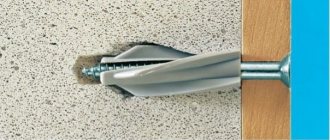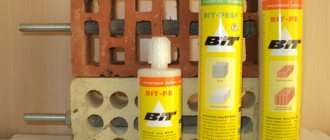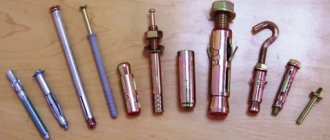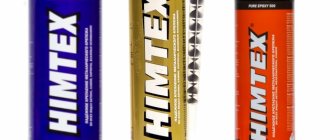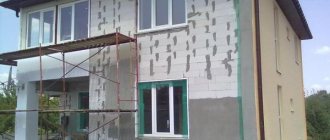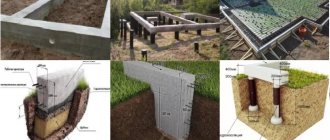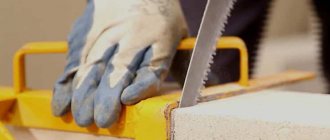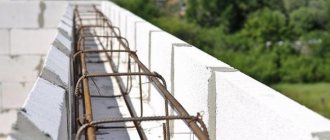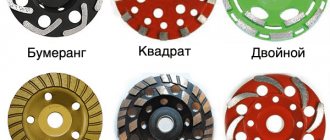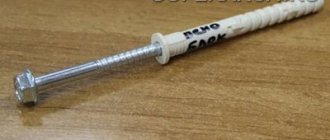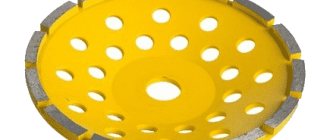Beton-House.com
Website about concrete: construction, characteristics, design. We combine the experience of professionals and private craftsmen in one place
Conventional hardware for aerated concrete is not suitable
Having a long list of positive characteristics, aerated concrete is a rather fragile material. This causes problems when attaching structural elements of the building, cladding, electrical and plumbing equipment, and furniture to it. Therefore, special fasteners for aerated concrete were developed, with the help of which these problems are solved simply and effectively.
This article will describe the most common fasteners and how to use them.
Fastening building structures to aerated concrete
On such fragile walls it is necessary to fix not only wires and pipes, but also heavy structures: floors, roofing elements, etc.
In such cases, fixing self-tapping screws into aerated concrete is not a solution; a serious decision is needed. As a rule, it is carried out during the process of laying walls, when a monolithic reinforced concrete armored belt is made at the installation level of such structures. During pouring, studs and other embedded parts are installed into it, onto which the fastening is subsequently carried out.
If for some reason you did not make an armored belt, or did not provide mortgages in it, fastening is carried out only with chemical anchors.
When choosing fastenings for aerated concrete walls, take into account such features
When choosing hardware, take into account the strength of the working surface, the dimensions of the parts and their resistance to corrosion.
The higher the density of the material, the stronger the aerated concrete. This indicator sets the load limits on the fastener. Technical characteristics in digital terms are indicated on the packaging of building blocks after the letter D.
The strength of the connection is affected by the size of the dowels. Thus, when fixing massive structures, products of large diameters and lengths are used.
The resistance of fasteners to corrosion ensures the possibility of their use when installing external structures and arranging unheated premises.
Dowel for facades “EJOT”
German facade dowels “EJOT” are specially designed for fastening in aerated concrete. They are used for fastening brackets for suspended ventilated facade systems and other hanging metal parts, as well as for fastening gates, doors, windows, water heaters, and cabinets.
Dowels for facades "EJOT" have:
- high load-bearing capacity;
- reliable fixation due to the combined expansion zone; when twisted, it wedges geometrically; temperature and electrical insulation;
- versatility - they can be used both outdoors and indoors.
| Size | Actual pullout load | Permissible pull-out load |
| SDP-RB-10S 100 mm | Sibit B2.5 ≈ 280 ÷ 350 kgf | 0.6 kN |
Scope of application
Chemical anchors in aerated concrete are used less frequently. It is used in cases where it is necessary to provide reliable fastening for massive objects. Mechanical anchors are not capable of supporting, for example, the weight of massive equipment.
Epoxy compounds are used mainly on solid bases. They are used for fastening:
- wall structures;
- beams;
- fences along roads;
- creating noise-insulating screens;
- when installing reinforcement outlets;
- when installing attachments.
This composition can be used:
- in a humid environment;
- under the water;
- both outside the building and for interior work.
Its composition:
- does not create stress in the structure of the porous wall;
- does not contain styrene;
- creates fastenings with smooth reinforcement.
The hardening of the mass depends on the air temperature. The time can last from 7-180 minutes. or 7-48 hours.
Polyester anchors are used to create:
- enclosing structures;
- when installing façade elements;
- for installation of translucent elements;
- during installation of utilities.
Typically, threaded rods are installed along with polyester compounds. The polyester anchor does not contain styrene. Therefore, it can be used on interior and exterior fasteners. The polyester anchor takes from 2 to 30 minutes to set and hardens from 25 to 180 minutes.
The anchor bolt for aerated concrete can be smooth or threaded if a vinylester anchor is used. It is used to create fasteners in wet substrates. It does not create unnecessary stress in the structure of aerated concrete. This adhesive solution is safe because it does not contain harmful substances. It is used for making internal and external fasteners. Does not create stress after installing fasteners in the structure of the aerated concrete block. Hardening is observed after 15 minutes or a day.
Epoxy acrylate anchor composition has become more widely used due to its properties. The period of setting and hardening of the composition is 2-24 and 15-180 minutes, respectively. Epoxy acrylate retains its properties when the temperature drops to -5°C, and also resists fire in case of fire for up to 2 hours. Epoxy acrylate anchor composition is suitable for anchoring floor slabs in aerated concrete houses.
Fastening requirements
There are also a number of requirements for fastening elements:
- They must be selected taking into account the environment. If the room is too humid or the temperature is constantly changing, the highest quality fasteners are needed, preferably with a zinc coating. The location of use is also taken into account here. For example, in a heated garage or outside.
- It is important that the chosen fastenings do not create tension within the elements.
- They must not contain toxic agents.
Why you shouldn’t attach excessively heavy structures to gas block and foam block
About the gas block
Autoclaved aerated concrete has thermal conductivity characteristics close to foam plastic because, like insulation, it contains air bubbles in its structure. At the same time, foam plastic has almost zero load-bearing capacity.
Why should a gas block be so much more durable? It should be noted that it copes well with a load evenly distributed over an area, for example, in wall masonry. But it does not tolerate local loads from ordinary dowels and anchors, that is, it simply does not hold
And no matter what the manufacturers of such blocks say, you need to load the material locally with great care - use special fasteners, spread them over a large area, do not hang very heavy structures without a metal frame
Excessive load on aerated concrete can lead to similar consequences
The weakest point of an aerated block in terms of load-bearing capacity is variable pressure. Periodically attaching and removing any heavy structure from an anchor will contribute to the crumbling of the material around the fastener and failure of the attachment point.
About the foam block
Foam concrete is used less frequently in modern construction, and on average it is heavier and stronger than aerated concrete. Of course, strength depends on the class of the material - the higher the class, the more durable it is, but at the same time it loses somewhat in its heat-insulating properties.
Perhaps we can say that the foam block is somewhere between concrete and aerated concrete in terms of strength. However, when choosing an anchor for foam concrete, it is better to be guided by the same principles that apply when using aerated concrete.
Characteristic
Aerated concrete is rightfully recognized as one of the most practical and affordable materials. It makes durable and strong houses, as well as reliable outbuildings. However, you need to take into account that this material has a cellular structure, when faced with which you need to take into account many nuances. The main characteristic feature of this material is its fragility and pliability. Porous blocks can be trimmed or cut off the excess part without any extra effort. And we must also not forget that special fasteners are used for such a structure. Traditional fasteners, as a rule, do not adhere well to such foundations, which is why the whole point of their use is lost.
For aerated concrete, special dowels should be used. The design of such parts is a sleeve in the form of a spiral, on the surface of which there are ribs. When screwing in a self-tapping screw, the last elements become wider, so they fit firmly into the loose aerated concrete surface. This simple but effective device can easily withstand impressive loads. With the use of special dowels, home owners have the opportunity to hang heavy decorative objects of any size on the walls.
Modern manufacturers produce these types of dowels in two variations. They differ in design features.
- According to the shape of the fixation ribs. Such fasteners can be equipped with a classic helical spiral or have cone-shaped ribs. The edges of the latter may resemble spiral-like blades.
- By installation method. The dowels are either screwed into the base or driven into it. Screw-in types are considered to be the most reliable. It is recommended to use driven-in fasteners if the aerated concrete floor is planned to be equipped with a collet.
Fastening building structures to aerated concrete
In general, the process of installing fasteners is similar for all options. First of all, a hole is made, and then the cartridge is inserted. The only difference can be with a chemical anchor, since it uses glue.
Chemical anchors are secured as follows:
- Preparatory work. You need to drill a hole using a drill.
- Next, the hole needs to be cleaned of dust. To do this, use a brush or a medical bulb.
- A cartridge with a chemical composition is installed. To do this, you need to insert a capsule with glue into the recess. The last one is squeezed out.
- An anchor is screwed into the hole.
- You need to wait until the glue dries. There are times when you need to wait 2 days for complete drying. It all depends on the composition, but temperature, humidity and other environmental features are also considered important factors.
- Once the compound has hardened, you can install the washer and nut.
The installation process using a mechanical anchor, dowel nail or self-tapping screw is the same, but without the use of glue.
This is what the fastening looks like inside aerated concrete.
Video on the topic:
Each fastening method has its own advantages and disadvantages. When choosing, you should take into account the material, density, and characteristics of the room.
Previous entry How to attach a window sill to a plastic window Next entry Features of attaching gates to brick pillars
Dowel
The part is a spiral-shaped bushing with ribs on the surface. At the moment the screw is screwed in, they expand, due to which they firmly fit into the soft surface of the base. Such fasteners can be made of galvanized steel or plastic.
The first option is the most common and is considered the most expensive. It is used when installing profiles, installing attachments and furniture, and fixing various pipelines. Such fasteners have become widespread in fire-hazardous spaces.
Metal dowels for aerated concrete are produced in 2 modifications, which differ in design features and installation methods. The parts can either be screwed into the base or driven into it. The latter option is used if the aerated concrete floor is planned to be equipped with a collet.
Based on the shape of the fixation ribs, fasteners with a classic helical spiral and dowels in the form of a cone, equipped with spiral blades, are distinguished. The design of metal elements also provides for the presence of a locking flange or cuff, thanks to which the part will not rotate.
Corrosion resistance is the main advantage of plastic products. The materials used for them are polypropylene and polyethylene. The positive characteristics of the parts include their efficiency, environmental friendliness, and immunity to aggressive environments. Such dowels are not intended for outdoor work, since with the onset of cold weather the plastic may burst.
A separate group consists of fasteners for aerated concrete made of nylon. They are more wear-resistant, so they can be used for cladding facades. Together with them, galvanized screw elements with 2 types of heads are used - countersunk or hexagonal. The disadvantage of this type of fastening is the high price.
Depending on the scope of application, there are several types of dowels:
- Universal. It can be mounted in any concrete surface. In a solid base, fixation occurs in a standard way. In a cellular coating, the product is rolled into a persistent knot. However, the load-bearing capacity of universal dowels is lower than that of spacer elements.
- A dowel-nail that has a wide range of applications. At the moment of fixation, a nail is inserted into the fastener, rather than a screw being screwed in. In order to avoid turning the part, use a sleeve.
- The “pancake-like” structure of the frame dowels allows you to reduce the load on the porous surface of the block.
Dowel for concrete - types of fasteners
Builders and private developers sometimes have to install a dowel in a foam block. To accomplish this task, dowel fasteners made of various materials are used.
Products come with a standard helical spiral or with cone-shaped ribs, the edges of which resemble spiral blades
The decision in choosing a specific type of fasteners is made depending on a number of factors:
- effective loads;
- operating conditions;
- fastening features;
- wall material.
Dowel fasteners made from various materials are used:
- metal Traditionally, steel is used, on the surface of which a protective zinc coating is applied. The metal structure is resistant to elevated temperatures and is widely used in industrial environments. The metal provides an increased level of strength when performing complex work on the installation of special pipeline equipment: water mains, sewer systems, gas networks. Metal fasteners provide reliable fixation of guides intended for installing drywall, as well as suspension of heavy furniture. The metal dowel for aerated concrete does not rotate in the porous mass, thanks to the locking collar. Galvanized metal products are distinguished by an increased price associated with the possibility of reuse and increased reliability;
- plastic. The plastic dowel for aerated concrete has a serious advantage compared to other structures. It is not subject to corrosion processes, and also provides an increased coefficient of adhesion to the cellular surface due to helical protrusions. Polypropylene and also polyethylene are used as materials for the manufacture of plastic retainers. The peculiarity of plastic fasteners is ease of installation, fairly low price, as well as increased resistance to aggressive environments. Experts advise using fasteners made of this material to fix plumbing lines and steel profiles when performing installation work in rooms with high moisture concentrations. When used in subzero temperatures, strength decreases as the plastic may burst;
Fasteners for porous building blocks are made from various materials
nylon. This is a proven material from which corrosion-resistant dowels for aerated concrete are made. Nylon, unlike conventional plastic, can be used in conditions of negative temperatures and, therefore, can be used not only for internal, but also for external work. In addition, the material, compared to polyethylene fasteners and polypropylene fasteners, has increased reliability. Nylon dowel bushings are used for mounting mirrors, fastening household electrical equipment, as well as when installing structures in window and door openings. The main disadvantage limiting the widespread use of nylon fasteners is their increased cost. Being a type of ordinary plastic, nylon used for the manufacture of dowel fasteners is superior to plastic in terms of performance and conditions of use.
There is also a frame dowel for gas silicate, brick, concrete, expanded clay concrete, gas blocks and other building materials. For its manufacture, any of the specified materials are used. The original design, which when screwing the fixing screw takes on a pancake-like configuration, allows you to increase the contact area and, accordingly, increase the reliability of fixation.
Tool and surface features
Installation tools:
- electric hand drill;
- drill bit with pobedite tip;
- hammer;
- a wrench or screwdriver for screwing in a screw;
- adhesive mixture for chemical anchor;
- special gun for glue mixture.
The main condition when installing objects and accessories is the correct choice of hardware.
Aerated concrete, having a porous structure, is a relatively fragile material, so the question arises - what kind of hardware is needed to ensure that the fastening is reliable and meets all the operating requirements of the structure.
There is a wide range of products that make it possible to fasten structures reliably and quickly.
From the video below you will learn about fasteners for aerated concrete.
Features of choice
There are now many types of anchors available for sale that are suitable for working with aerated concrete. Which one is better to choose will depend on the specific case. For example, to install hanging mirrors and lamps, it is advisable to use nylon fasteners with a diameter of no more than 12 mm. When installing pipes, metal products are always used. To secure heavy pieces of furniture, it is recommended to install special metal dowels.
When working on a facade surface, it is recommended to buy special plastic fasteners designed for facades. Frame fasteners are perfect for installing window and door frames.
Correct installation of such fasteners will make it possible to support objects with very heavy weight. You shouldn’t skimp on purchasing high-quality dowels to ensure the fastening is as strong and reliable as possible.
Why does foam concrete need special fasteners?
Foam blocks are made from water, sand, cement and a special foaming agent. The blocks are cellular, the material is fragile enough for installation of various fasteners.
The main distinctive features of foam blocks: low weight, low density, high level of hygroscopicity, porous structure. For the most part, properties act as advantages during the construction and operation of buildings, but not at the moment of attaching some objects to the walls.
The structure of foam concrete is porous, the adhesion to materials is not very good, so the blocks cannot always cope with the loads, and therefore special dowels are provided for them.
Properly selected fasteners for foam blocks will not only secure equipment or furniture with high quality, but will also strengthen the working structure and significantly increase the percentage of permissible loads.
Fasteners for foam blocks require a certain design of fixing parts - they usually consist of the following elements: a screw, a ring, a half-ring, a side, an empty sleeve with a spacer. Many anchors are made with teeth, which become a reliable obstacle to the part turning.
There are also chemical anchors for foam blocks, which are created specifically for use and provide maximum quality of fastening. In this case, the main task of the dowel is to create internal support in the block during the expansion process inside the aerated concrete and preserve the fragile material from destruction.
Dowels can be of different diameters and lengths, made of metal or plastic, and are supplied in packs of 50-1000 pieces. According to the scope of application, they are intended for external/internal work, according to the installation method - driven, screwed and others (chemical anchors are distinguished separately).
Chemical anchor
This type of fastening, such as a chemical anchor, is a fairly new and already in demand method. The builders appreciated it. Chemical anchoring has its advantages and disadvantages. The advantages of a chemical anchor include:
- high load capacity factor on fasteners;
- compliance with GOST, the chemical composition is safe and environmentally friendly;
- versatility, it is used for any building material;
- high resistance to weather fluctuations and low temperatures;
- low price when compared with steel anchors.
The disadvantages include:
- strict adherence to technology;
- purchase of special equipment, namely brushes, pumps, guns and drills;
- additional time for the chemical solution to harden.
Chemical fasteners for foam concrete include a threaded steel pin, maybe a special rod, a chemical mixture, and additional bushings.
Chemical anchor fastening sequence
- Use a drill to make a cylindrical hole. Then it needs to be shaped into a cone with an expansion in depth.
- The finished hole is thoroughly cleaned. You can use a pump for this.
- A centering sleeve is inserted into the base.
- A chemical solution is poured into the hole through the sleeve; a construction gun is used for this.
- The threaded rod (stud) is screwed in.
- Leave time until the chemical solution hardens completely.
The chemical anchor kit includes an easy-to-use package with a dispenser. Installation is easy, while achieving high structural strength.
Fastening chemical anchors
And so, for fastening light structures and decorative elements, ordinary self-tapping screws are quite suitable. They can be designed for working on wood or on cellular concrete. Nails for aerated concrete should have a wedge shape or a curved tip inside the concrete cavity.
For heavy structures, such as plumbing fixtures, kitchen cabinets, boilers, it is worth using foam concrete fasteners with wedging dowels. Reliable fixation is achieved precisely thanks to the internal stop. All hardware must be resistant to corrosion. This especially applies to mountings on an external wall.
Fasteners for aerated concrete: which is better?
When deciding which fasteners are best for aerated concrete, it is recommended to familiarize yourself with the technical features of each type.
Dowels
These are peculiar bushings with a rough outer surface and four “petals”. During the twisting process, they begin to expand, penetrating the blades into the porous structure of aerated concrete blocks. This ensures reliable fixation of the sleeve.
For the manufacture of dowels the following can be used:
1. Metal – stainless, galvanized, aluminum, brass.
2. Plastic – polypropylene, nylon, polyethylene.
Metal fasteners
Fastening steel products are characterized by greater reliability in operation. With their help, you can carry out complex and through installation without any problems. A significant disadvantage is oxidation under prolonged exposure to moisture.
This type of fasteners is in great demand for:
- hanging furniture and equipment with impressive weight;
- fixing pipelines of varying complexity;
- fastening load-bearing guides for various plasterboard structures.
Plastic fasteners
Plastic can ensure ease of installation. In addition, such fasteners are multifunctional and resist corrosion well. Plastic fasteners for aerated concrete blocks are very popular due to their low cost. However, they are not recommended for installation on external walls, since they do not withstand fluctuations in ambient temperature.
Chemical dowels
They are widely used for fixing massive objects on gas blocks. To do this, it is enough to place a capsule with a special adhesive composition into a pre-prepared hole.
Tips and tricks
When installing dowels into a gas block, you cannot use a screwdriver, since this device runs on electricity, which makes it more difficult to control. Such a device can strip the thread by twisting the screw
When making a hole for dowels in a gas block, it is important to note that they should not be larger than their diameter. Otherwise, the fasteners simply will not hold securely in the base
The depth of the holes should be slightly greater than the length of the dowel. The tip of the screw must leave the dowel for the fastening to be as reliable as possible.
Many people, having become acquainted with dowels, begin to use them at any opportunity. However, experts do not advise using too powerful fastenings if you plan to hang hooks, pictures and other small items. For such purposes, simple plastic fasteners, the size of which is about 8 mm, are more suitable.
About fastening for aerated concrete - a nylon dowel and a metal dowel (crocodile), see the following video.
Self-tapping screw and dowel nail
For strength, high-tech steel hardware is coated with different protective layers, this depends on the further use of the screws. Silver galvanized ones are considered universal; they are used for all types of work. Golden galvanized ones are used more often inside the building. Black, oxide-coated ones are used only for interior work.
Self-tapping screws are also selected according to color, which matches the color schemes. All kinds of elements (paintings, candlesticks, flowerpots and other decorative items) are most often attached to golden-colored consumables. Manufacturers offer aerated concrete self-tapping screws with multi-colored caps coated with anti-corrosion coating for these purposes. In order to hide the color and volume of the head, special masking fittings are offered.
Self-tapping screws are classified according to the following parameters:
- head diameter;
- thread pitch (width);
- screw length.
Types of fasteners and performance of work
The type of product is selected depending on the expected load:
- for fastening hanging mirrors or lamps, nylon dowels with a cross-section of up to 12 mm are suitable;
- when installing pipelines and bulky objects, choose metal parts;
- frame types of fastenings are used to fix window and door frames;
- universal facade dowels are used when installing external profiles for facing slabs;
- Only light objects are attached to wood screws - photo frames or decorative elements.
Installation is carried out in several stages.
In order for the products to fit tightly into the base, it is necessary to drill the holes correctly. To do this, it is best to use a hammerless drill or a hammer drill with the impact turned off. The drill should have a cross-section 1 mm smaller than the fastener itself. The only exception is steel hardware. For them, the hole will be reduced by 2 mm.
After cleaning the recess from concrete dust, install a dowel. The plastic fastener is screwed in using a screwdriver. Metal parts are driven into the mounting hole with a hammer. During the work, it is necessary to ensure that the product does not warp.
At the final stage, screw in a self-tapping screw or a standard mounting bolt. In this case, it is not advisable to use an electric tool, since when connecting to an aerated concrete block, the screw element may be damaged.
What fasteners should I use for aerated concrete?
Today the market offers an unlimited variety of fasteners for fixing various objects on aerated concrete blocks. However, to select the optimal fastener, it is necessary to take into account the specific working conditions with the gas block.
For example, you can use plastic hardware to attach lamps or hanging mirrors. But it is better to install pipelines using metal dowels. It is more rational to fasten facing bricks to aerated concrete using galvanized flexible connections.
If you are planning to engage in low-rise construction of houses from aerated concrete blocks in Russia, Kazakhstan, Uzbekistan or another country, we recommend that you familiarize yourself with our catalog. Here you will find equipment for independent production of gas blocks . This way you will be 100% sure of their quality.
Fasteners for cellular concrete
Using ordinary wood screws, only very light objects such as photo frames can be attached to aerated concrete. In all other cases, special fasteners will be required.
Fastening requirements
When choosing which fasteners to use for aerated concrete, you need to consider the following points:
The density of wall blocks, indicated in product labeling by numbers after the letter D. The higher it is, the fewer pores in the material, and the stronger it is. The load limit when pulling out fasteners depends on this indicator, and the manufacturer’s instructions on the packaging contain this information.
The numbers show how many kilograms are in a cubic meter of material
The fastener parameters are its length and diameter. The larger they are, the greater the load it can withstand. The load-bearing capacity must also be indicated on the packaging or certificate.
Chemical anchors have the highest load-bearing capacity
Corrosion resistance. This parameter is especially important when fastening into aerated concrete is carried out from external walls or in unheated rooms. Steel hardware must be coated with a protective layer.
Punch for aerated concrete
Mounting options
Let's take a closer look at which aerated concrete fasteners are used most often.
Let's start with the traditional types:
| Image | Application |
| When a smooth steel nail enters the sleeve, its base opens and enters the material at an angle. Suitable for all types of concrete. |
| Allows you to attach a profile to aerated concrete to fasten facade panels and hang wall cabinets and shelves. |
| Universal nylon expansion dowel | Used only for small loads: fastening light shelves, curtains, baseboards, switches, cable ducts, etc. |
| Helps to fasten window and door frames and wall cabinets to aerated concrete. |
| Nylon dowel for aerated concrete | Special development for aerated concrete. It is used with conventional self-tapping screws when installing wooden and metal facade subsystems, windows, doors, suspended ceilings, sanitary equipment, and pipelines. |
| Designed for any cellular concrete, the scope is wide. |
| Steel anchor for aerated concrete | Solves the problem of how to attach heavy objects to aerated concrete: water heaters, air conditioners, hanging pipes, heavy wall cabinets, etc. |
All these elements may have other varieties that differ from the images shown in the table. For example, turbo dowels with self-tapping threads are made from nylon.
Turbo dowel FTP K
And made of galvanized steel - four-leaf toothed expansion dowels. Their segments move apart when the screw is screwed in, reliably biting into cellular materials.
Steel expansion dowel
As already mentioned, one or another hardware and fastening method are chosen depending on the expected load.
If you need to fasten aerated concrete shelves, you need to carefully drill at a right angle, insert a dowel into the hole and screw a screw into it.
Shelves with covered mounting on aerated concrete wall
- And to hang a light picture or install an electrical switch, a simple self-tapping screw screwed at an angle of 45 degrees to the wall is enough.
- If you need to securely fasten heavy equipment or install a metal entrance door, it is best to use chemical anchors.
When installed, they are capsules made of synthetic resins and organic polymers that seal holes in a wall made of aerated concrete, firmly holding a metal rod or threaded rod in it.
The advantages of such fastening include exceptional reliability and durability, the adhesive base is not susceptible to thermal expansion and resistance to aggressive environments.
No special qualifications are required for fastening with chemical anchors; everything can be done with your own hands.
For this:
- A hole of the required depth is drilled in the wall, its bottom is slightly expanded by oscillating movements of the drill;
- Construction dust is blown out of the hole, and a sleeve is inserted into its neck;
- The cavity is filled with adhesive solution using a mounting gun;
- An anchor rod is immediately installed into it;
- After the solution has hardened, fastening can be done.
The price of such fasteners is higher than that of other types, but the reliability does not raise the slightest doubt.
Mounting options
The fasteners used to fill the holes include resins:
- epoxy;
- epoxy acrylate;
- polyester;
- vinylester.
The choice of fasteners is also influenced by factors such as:
- terms of Use;
- environment;
- composition of the adhesive material.
Types of fasteners:
- dowel;
- anchor;
- self-tapping screw;
- spiral nail.
Each variety has its own pros and cons. The installation process for all fasteners is generally similar. The difference is in the materials from which they are made. Some can only withstand light loads, while others can withstand any weight, including large equipment.
Dowel
There are several types of dowels. Among them are:
- Dowel nail. Manufacturing material – steel. As the smooth nail enters the sleeve, the base begins to open. As a result, it enters the material at an angle. These fasteners can be used for all types of concrete.
- Facade universal. With its help you can attach facade panels to aerated concrete. It is also used for attaching wall shelves and cabinets.
- Universal nylon spacer. This dowel option is suitable for small weight items. For example, curtains and curtains, small shelves, switches, baseboards and cables.
- Frame. It is suitable for attaching wall cabinets, door and window frames to aerated concrete.
- Nylon. Made specifically for aerated concrete. It is mounted together with a simple self-tapping screw. Most suitable for wood or metal based façade systems, doors, windows, suspended ceilings, piping and sanitary fittings.
- Steel dowel coated with zinc. Suitable for any type of concrete. Can be used for almost all attached objects. The material can withstand the heaviest loads, and the zinc coating makes the fastening resistant to corrosion.
Mechanical anchor
A mechanical anchor for aerated concrete is ideal for massive structures. For example, pipes, air conditioners, water heaters, massive cabinets. Withstands the same load as a steel dowel, but due to the lack of zinc coating, it is more susceptible to corrosion. Mechanical anchors are also called butterfly anchors due to their shape.
Chemical anchor
A chemical anchor bolt is suitable if you need to fix a heavy object. The principle of operation is the same as that of mechanical anchors, but here you will need to use glue during the installation process. Thanks to this technique, it is possible to achieve reliable fixation in objects with low density, including:
- Gas silicate partition.
- Porous brick.
- Foam concrete slab.
Classification of self-tapping screws for aerated concrete and foam concrete blocks
| Profile | Diameter, mm | Length, cm | Photo | A comment |
| Nog | 7,5 | 7 — 20 | Dowel with dowel for foam concrete | Can be used in aerated concrete blocks without dowels. In foam blocks only with dowels. |
| Universal | about 6 | until 22 | Universal self-tapping screw for foam concrete | Average thread pitch. Can be mounted without dowels |
| Christmas tree (mef) | up to 8 | up to 20 | Christmas tree screw (mef) for foam concrete | Average thread pitch. Can only be used with mef dowels |
Dowels for self-tapping screws
Without dowels, self-tapping screws for aerated concrete are not often used due to the porous structure of the blocks. They are used for fastening lightweight structures. Thus, they can easily secure a reinforced mesh to an aerated concrete surface before applying plaster. For such fastening, self-tapping screws with a wide pitch and a length of at least 10 cm are selected.
In this case, it will not be possible to use a hammer drill, since the aerated concrete will crumble greatly. A drill with a thin drill bit is used. There is a way to screw self-tapping screws into a porous surface using machine oil. A few drops of oil are added to the prepared hole, so the hardware can be easily screwed in. The hardware will fit tightly, and it will be difficult to unscrew it in the future.
Self-tapping screws with a herringbone profile can be hammered into foam concrete blocks. The consumables along with the dowels are driven in “forever”; it is almost impossible to dismantle them. The work must be done quickly so that the prepared hole does not begin to crumble.
How to use?
The principle of installation of dowels is the same as for other types of fasteners. You need to act in the following order:
- first you need to prepare holes for the dowel, which should be smaller than the diameter of the fastening; for example, for 8 mm fasteners you will need to use a 7 mm drill;
- if you take a tool such as a hammer drill, then you need to turn off the impact mode; of course, it is advisable to use a drill, since it is more effective;
- the plastic fastener must be carefully screwed in using a screwdriver; if metal parts are used, then they should be driven into the mounting hole with a hammer;
- When performing work, you must ensure that the products do not touch or are positioned crookedly;
- when the cuff is installed all the way, you can proceed to screwing a self-tapping screw or a universal-type bolt;
- It is necessary to screw in the self-tapping screw using a screwdriver, adhering to the required depth.
Selection and features of fastening anchors for foam and aerated concrete
Which anchors are best to choose?
Anchors should be selected based on the weight that will fall on each individual fastener:
- Anchors that can support up to 10 kg per fastener. Such products work mainly due to expansion and are a thickened plastic element that in working condition acquires a conical shape or expands inside the material. With their help you can hang small shelves, pictures, hangers, etc.
Anchors for fastening lightweight structures into aerated concrete
- Anchors for a mass of 20-25 kg. These are fasteners of a special shape that allow the load inside the material to be distributed over the maximum possible area inside the base. They usually have a helical shape, significant length and diameter. They can be used to hang, for example, heating system radiators, kitchen cabinets, and façade cladding systems.
Anchors for fastening medium and heavy structures into aerated concrete
- Chemical anchors for 30kg and more. They are special solutions supplied in tubes. Under them, a long hole of large diameter is drilled in the aerated concrete base, cleaned, filled with the compound and a metal pin is inserted. After hardening, the solution essentially turns into a solid capsule, comparable in strength to concrete. At the same time, it takes on the local load from the suspended structures and, due to its large surface area, more evenly transfers this load to the aerated concrete. This solution allows you to attach boilers and other heavy interior and exterior elements to walls made of foam block and gas block.
Chemical anchors for fastening heavy structures to aerated concrete
When choosing an anchor for aerated concrete, give preference to dimensional products with a large surface area. The longer and thicker the anchor, the better.
Practical recommendations for fastening into aerated concrete
Before fastening it into aerated concrete with your own hands, remember that:
- Installation of fasteners must be carried out with a minimum distance from each other of 10 cm. Otherwise, the overlap of stress areas in the gas block can lead to its collapse and the fall of the structure being fixed. The greater the spacing of the anchors relative to each other, the better and more reliable the fastening.
- The anchor should not be attached close to the edge of the block; the minimum offset here is also 10 cm.
- As already noted, the class of aerated concrete largely determines its ability to withstand the fastening of massive structures. For example, a B2.5 class block will withstand approximately 2 times less weight compared to B5.0, although the latter is used extremely rarely in low-rise construction.
- Despite everything described above, it cannot be said that this or that fastening to aerated concrete can be considered 100% reliable. The material is fragile, and it will be better if heavy objects are secured through a specially mounted metal frame, rigidly fixed to the concrete floor and/or ceiling. At the same time, to save space, the frame can be “drowned” into easily chipped aerated concrete.
- It is necessary to drill holes in the gas block for anchors in the drilling mode without impact. The drill should be selected 1-2 mm smaller than the diameter of the dowel, so that after driving, the fastener “sits” tightly in the hole.
Video on the use of Fisher chemical anchors in walls made of various materials.
So, we figured out how and with what help you can attach to aerated concrete and foam concrete blocks. You can find out how to attach to other building materials in our next articles.
Possible fastening methods
Depending on the type of strapping scheme, one of two options for attaching the Mauerlat to aerated concrete is selected: pouring a monolithic reinforced concrete belt around the entire perimeter of the building or placing fixing elements directly into the masonry or blocks. The first method, in addition to ensuring maximum reliability, helps to redistribute loads, levels the walls and protects them from deformations, including shrinkage. The presence of an armored belt is mandatory when carrying out construction in areas with seismic activity, constructing houses made of aerated concrete over one floor, using heavy roofing materials, or complex roof shapes.
Standard instructions for laying it include the following steps:
Preparatory: calculation of fasteners and selection of the interval between them. The main guide is the rafter placement diagram: if the number is equal, the attachment points to the Mauerlat should not coincide with the places where the studs are screwed. Laying U-shaped blocks on top of the last row around the entire perimeter of the aerated concrete wall. They act as formwork, the recommended width is from 25 cm. Assembly of a reinforcing frame from rods with a thickness of 10 mm. At this stage, it is planned to lay pins to fix the Mauerlat at intervals of no more than 1 m, strictly vertically, tied with wire to the main rows
Particular attention is paid to the corners; in these areas, metal rods are bent to a length no less than the width of the belt. Similar actions are repeated along the entire perimeter of load-bearing walls, including gables and partitions. Organization of an insulating layer made of compacted polystyrene foam
It is placed closer to the outer edge of the aerated concrete wall. Filling the internal cavity with concrete with a strength grade of at least M200, compacting, removing excess and carefully leveling the top layer. Cover with polyethylene and standard moisture care during the first days.
You can begin the next stage of tying the Mauerlat to the aerated concrete walls in a week. All formwork structures are removed (they are used when pouring a monolithic reinforced concrete pad along the entire perimeter and width; this design is typical for brickwork, but is sometimes used for houses made of gas silicate). Next, 2 layers of waterproofing are laid or coated on top of the upper side in contact with the future Mauerlat; this stage cannot be skipped. Attachment points are marked on a wooden beam treated with antiseptics and fire retardants and well dried. The easiest way to do this is by placing it on the armored belt over the studs and hitting it with a sledgehammer; holes are drilled according to the diameter of the rods (at least 14 mm). After this, all that remains is to attach the Mauerlat to the aerated concrete wall and tighten it with nuts or washers.
The final stages of the work are difficult to complete on your own; at least 2 people will be required. In addition to main walls, the armored belt is mounted on any areas on which roof elements rest (for example, ridge posts or beds). If you have no experience, you should watch video instructions on the topic “how to properly attach the Mauerlat.” If you need to eliminate errors that occurred during the laying process, it is better to contact specialists, at least for advice. Installation of rafters is possible only after completion of all work on fixing the Mauerlat and checking the quality of connections.
Feasibility of application
Chemical injection compositions and ampoules are expensive, their purchase is advisable when working with hollow and porous types of concrete; in dense structures they are justified when installed near the edge or in the case of increased expected loads: tensile, vibration, weight. Anchors of this type can withstand the weight of steel elements, consoles, columns, facade systems, equipment, fences, and, if necessary, they are used for additional fastening of reinforcing bars. When choosing this option, the quality of the base material has virtually no effect on the reliability of the fixation; the products of Hilti, Fischer and their analogues are designed for use in concrete with cracks.
They are also advised to buy:
- In the absence of an accurate calculation of the hole size.
- At high seismic and vibration loads on the object.
- If necessary, violation of the recommended intervals: placement along the edge of the structure or next to an adjacent anchor. Unlike standard dowels for concrete, they do not have a thrust force.
- For use in conditions of high humidity (the chemical composition reliably protects metal fasteners for concrete from corrosion).
- For installation in fire protection systems, the fire resistance of specialized types reaches 2 hours.
Proper use of fasteners
The reliability of assembly units when working with aerated concrete and foam blocks depends not only on the choice of fasteners, but also on compliance with a number of rules for their use. There are certain rules, if you follow which you will not be mistaken when choosing fasteners and will not make gross mistakes in installation:
- Aerated concrete and other cellular building materials tend to form chips along the edges. Do not make a hole for attaching a dowel under a window frame or door block at a distance of 5–7 cm from the edge, otherwise the block will definitely fall apart from overload.
- Plastic dowels should “sit” inside the aerated concrete at least 5–6 cm from the wall surface.
- Before placing an anchor or dowel inside a drilled hole, clean the passage from dust by blowing and using a special brush.
- It is better to avoid using a screwdriver to screw fasteners into aerated concrete. When using a screwdriver, you may accidentally turn the fastener inside the hole, which will lead to loss of fixation strength.
- To increase the reliability of the fasteners, plaster the surface with a mixture of cement and fine construction sand.
Before buying fasteners for foam blocks, make sure that its load capacity matches the weight of the loads being mounted.
